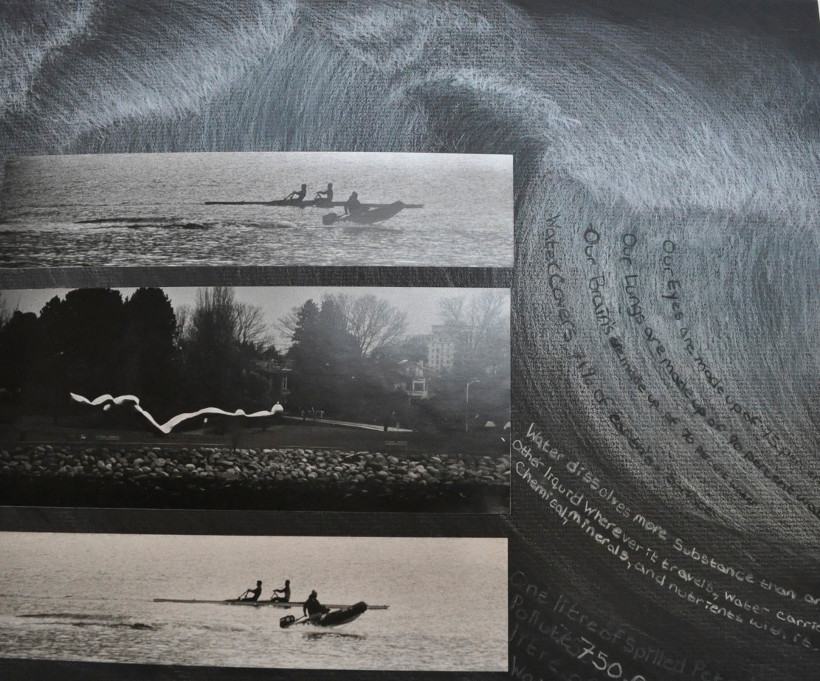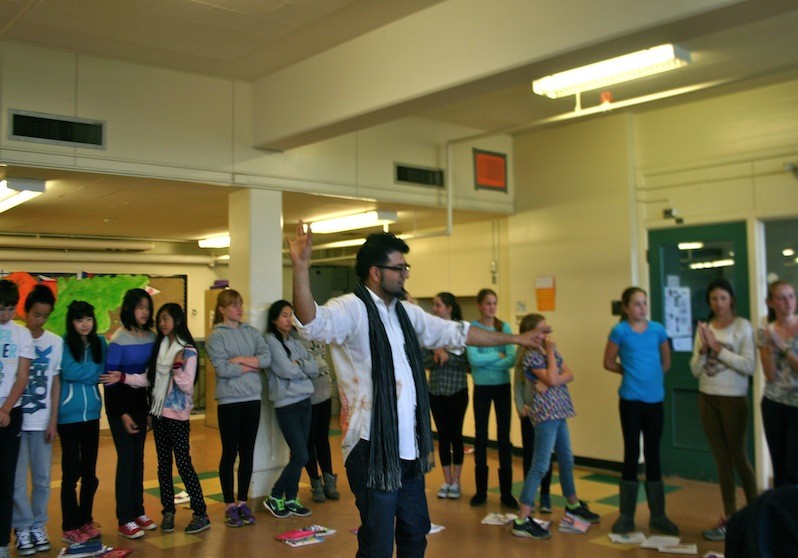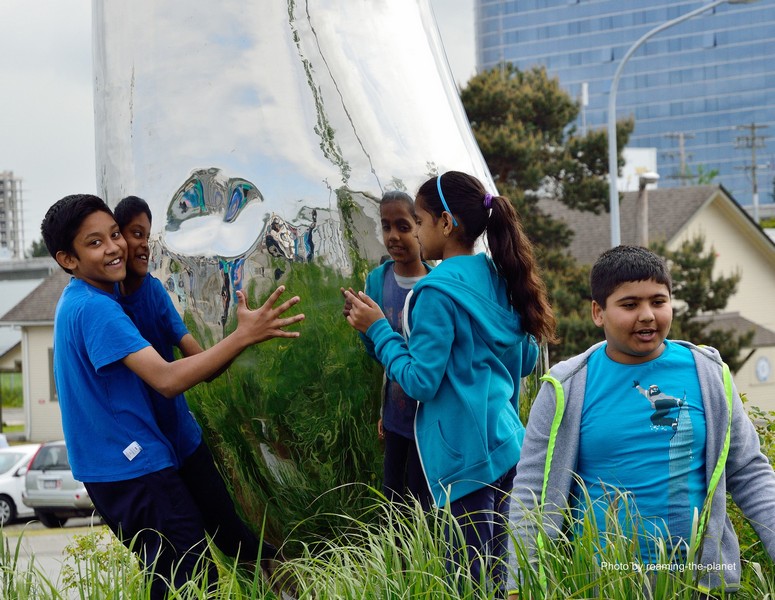Water Systems
Science - Grade 8
This unit of inquiry is not a recipe book but rather a launchpad to inspire new BIG IDEAS. We encourage you to use and/or modify one, or several of the BIG IDEAS below. Adapt it to the grade/ ability level of your students.
Enduring Understanding
Water Systems Connect Our World
Guiding Questions
How does water shape our environment? Given Vancouver being the Crossroads of water systems, what is the impact of waterways on our environment?
Mind Opening
Choose or devise practices to encourage students to be open to new experiences and ways of thinking in your classroom. For example, the MindUP in-school program.
Discovery and Inspiration:
Launch the Project
• Introduce the Theme: Present the Enduring Understanding and Guiding Questions using vocabulary that is appropriate for your grade level.
• About Vancouver Biennale: Play a short video.
• Create Project Space: Brainstorm ideas to make the project theme visual and visible using bulletin boards, and/or a project corner to share relevant materials and inquiry questions and processes.
Reference Resources:
• Introduction to Sculpture and Public Art Unit Plan for information on how art has evolved over time and the unique experience sculptures and/or public art brings.
• Vancouver Biennale 2014-2016 Exhibition Theme: Open Borders / Crossroads Vancouver
• Water #10 (Ren Jun, China) of Vancouver Biennale 2009 – 2011 Exhibition
• About Artist and Artwork (PDF)
Other Resources
National Geographic Website: Freshwater Rivers Photos, Oceans Photos
National Geographic Education: Mapping Ocean Currents
Learning to Learn:
Art Inquiry
Make a visit to Water #10 and encourage students to freely explore and interact with the art pieces individually and in groups. This Art Inquiry process enables the students to practice observing, describing, interpreting, and sharing visual information and personal experiences. Use the Art Inquiry Worksheet (PDF) to guide and capture their ideas and impressions. Customize or create your own Art Inquiry Worksheet as appropriate for your project and class needs.
Making reference to the Guiding Question, facilitate discussion on the impact of radioactive water dumping from Fukushima nuclear plant into the Pacific Ocean. Facilitate further discussion on how the floating debris is carried by currents off Japan towards the Pacific Rim and back to Asia via Hawaii.
BIG IDEAS Anywhere educators: View the Water #10 Guided Tour Video MUTE ON and encourage students to explore at different angles individually and in groups.
Shared Insights
• Sharing Art Inquiry Experience: Ask students to share the Art Inquiry Worksheet responses in class.
• View Guided Tour Video: View the Water #10 Guided Tour Video again with SOUND ON.
• Artist Themes – Research: In small groups students rotate between information stations detailing the artist’s life and work. Station topics include: (1) education and training; (2) lifetime of artwork; (2) materials and processes; (3) beliefs and values. At each station, students answer questions and complete a task. For example, at the station “life’s work” students might plot the artist’s various installations on a map of the world.
• Artist Themes – The Role of Gravity: Despite weighing seven tons, Water #10 has no angles or hard edges, giving it a free flowing form and weightless, fluid appearance. Discuss how gravity plays a role in this art installation and in the creation of surface and deep water currents. Facilitate a discussion on the plastic ‘floating island’ in the Pacific.
Inquiry Challenges
Using what we know about ocean currents in the North Pacific, calculate the length of time it would take a floating object to circumnavigate the region.
What impact does this finding have on our understanding of the inter-connectedness of the water systems? The biosphere?
Using the flow of water in the Fraser River, calculate the time it would take pollution from a toxic spill in Prince George to reach Vancouver.
Connecting to Ren Jun’s Water #10, break the class into teams of four, have them create visual examples (time lapse drawings, interpretive play, before and after imagery, storytelling through the minds of animals along the way) of a single drop of water in a river or ocean flowing over time to depict the impact to Vancouver of an oil tanker spill in Burrard Inlet? Off the coast of Kitimat? An oil spill from a pipeline crossing the Fraser River at Quennel?
Student Creation
Students and teachers decide on medium and methods to communicate their insights on water systems on earth. Consider use of posters, websites, montages, written essays/poems, film and audio, dance, visual arts or theatre.
Taking Action
Students can decide individual or group projects to promote their learning to the broader community for long-term influence. The focus being students as learners and communicators, to engage with an audience to get feedback, and ideally, the action is propelled even further.
Reflection
• Teacher and students can reflect on their entire learning process by revisiting the Enduring Understanding and relevant Guiding Questions.
• How did the unit of study open inquiry, create cross–curricular learning opportunities and/or apply learning to real life situations? Has this unit of inquiry changed your opinions, values and world view? In what ways, if any, has it helped you grow as a learner?
Ideas for Cross-Curricular Access
• Arts Education (Visual Arts): Create drawings of abstract representation of water system and/or water in different states/forms.
• Language Arts: Read the book People of the Naas River. Discuss and reflect on the relationship of the river and its watershed and Nisga’a, the people who live in the Nass River Valley of northwestern British Columbia. Consider the aspects of food, fur, tools, plants, medicine, timber, and fuel.
• Social Studies: Given that Vancouver is a crossroads of water systems, research and reflect on the impact of waterways in the development of world civilization during the time period being studied (500-1600) – consider: society and culture, economy and technology and environment. Specifically discuss how waterways in Vancouver played an important part on the settlement of Early First Nations here. Consider the critical role of water system in food resources, transportation, spiritual beliefs and ceremonies. Fast forward to present day and discuss how water systems again play an important part in Vancouver becoming an economic hub.
Credits
Written by: Terry Howe, Curriculum Consultant and Retired School Principal
Contributor: Katherine Tong, Vancouver Biennale Education Program Director
Edited by: Jennifer Massoud, Secondary School Teacher
©2013 Vancouver Biennale



